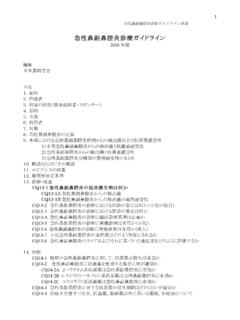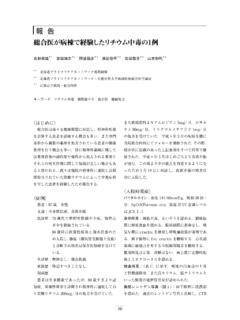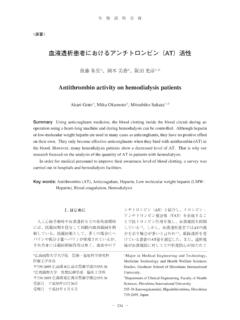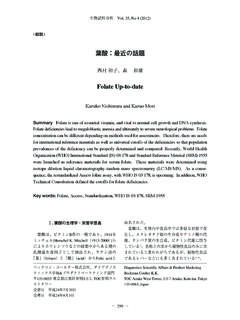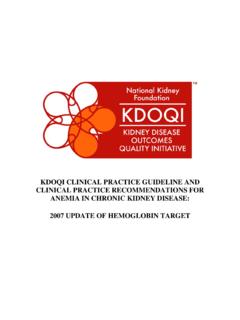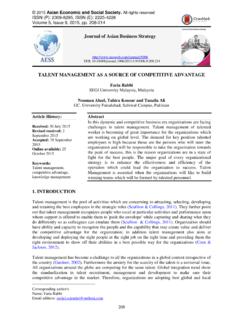Transcription of Optimisation of ammonium sulfate precipitation method …
1 Int J Anal Bio-Sci Vol. 2, No 1 (2014). Original Article . Optimisation of ammonium sulfate precipitation method to achieve high throughput concentration of crude alkaline phosphatase from Brown shrimp (Metapenaeus monoceros) hepatopancreas Krishna Prasad Nooralabettu Summary Effectiveness of various pH and ammonium sulfate saturation level in the pancreatic samples that has been homogenised at 3,000 rpm for 10 min at 4 and clarified at RCF of . g for 5min at 4 to concentrate alkaline phosphatase with optimum yield and purity was determined. precipitation performed using M Tris-HCl buffer of pH containing M MgCl2 and ZnCl2. produced optimum yield and activity in comparison to the precipitation performed using 2 M KCl solution of pH 7, and hence components and pH of the buffer plays a major role during concentration.
2 The salt saturation level of 65% at pH reduced the volume of the precipitate to one third, fractionated half of the proteins away from the precipitate, purified the enzyme by folds, and increased the enzyme yield by , compared to the initial homogenates, as it achieves optimum concentration along with partial purification of the enzyme with optimum yield and activity. Below 65% saturation level enzyme yield was reduced and above this level enzyme purifi- cation was inefficient. Key words: Alkaline phosphatase, Shrimps, Insoluble, Clarification, precipitation 1. Introduction tions 1-3. However, these impurities with narrow variation in their physico-chemical properties are the Hepatopancreas of shrimps is an important organ bottle neck during the purification of alkaline functions in food absorption, transport, secretion of phosphatase to commercially exploit it, including its digestive enzymes, and storage of lipids, glycogen, and use in dairy, medicine, leather processing and a number of minerals, hence is a very good source of bioprocess industries.
3 Concentration of the alkaline varieties of commercially important products such as phosphatase by exploiting physico-chemical properties enzymes adapted to various environmental condi- of the components of clarified hepatopancreatic tissue Professor, Department of Biotechnology, College of Abbreviation: RCF = Relative Centrifugal Force, AMP = 2- Engineering, Nadupadavu, Mangalore-574153, amino-2-methyl-1-propanol, ANOVA = Analysis of variance, Karnataka, India. pNPP = p-nitrophenylphosphate, pNPP = p-nitrophenol, Received for Publication November 27, 2013 Tris-HCl = Tris (hydroxymethyl) aminomethane hydrochloric Accepted for Publication December 2, 2013 acid solution 7 . International Journal of Analytical Bio-Science homogenate by ammonium sulfate precipitation is with reagents according to the current American critical at the initial stages of enzyme purification Chemical Society specifications15.
4 Tris-HCl buffer or itself as it efficiently reduces the bulk of the volume KCl solution was used as working buffers during the and partially purifies the enzyme, even though partial homogenisation and precipitation of hepatopancre- 4, 5. purification of the enzyme is incidental . Reducing atic tissues of shrimp. Working buffer, M Tris-HCl the bulk volume of the homogenate is crucial at the buffer of pH was prepared by adding g of initial stage of the purification itself as this on the the free Tris base to 900 mL of deionized water. This other turn reduced the requirement of space, quantity mixture is then titrated with 1 M HCl solution to pH. of the ingredients, scale of the operation, and associ- , and volume was made up to 1,000 mL.
5 The buffer ated cost of purification4. Hence it is need of the hour was added with MgCl2 and ZnCl2 to respective final to investigate the specific parameters required to concentration of 1 mM. Whereas, 2 M potassium precipitate alkaline phosphatase into a smallest volume chloride (KCl) solution was prepared by dissolving of the two phase developed during precipitation with g of potassium chloride using deionised water, optimum yield and activity while retaining other and pH was adjusted to 7 using M NaOH solution. proteins with similar physico-chemical properties in Assay buffer, 2-amino-2-methyl-1-propanol (AMP). the bulk of the volume through experimental setup6-8. buffer of pH was prepared by dissolving 78 g of This is possible because proteins with few hydrophilic AMP in 500 mL of deionized water.
6 To this resulting regions are precipitated at lower saturation level and mixture 200 mL of 1 M HCl is added. Subsequently, some other proteins with more hydrophilic region are volume of the mixture is made up to 1,000 mL using precipitated at higher saturation level without changing deionized water in 1,000 mL volumetric flask. Assay its native conformation of the precipitate9-14. Even buffer is used to determine the alkaline phosphatase though parameters of ammonium sulfate precipita- activity. Working buffer and assay buffer preparations tion is well researched and widely discussed, no single were filtered and sterilized at 121 for 20 min16. set of standard operating conditions to concentrate enzyme from the clarified tissue homogenate of the Sample collection shrimps in terms critical factors such as of ammonium Brown shrimp (Metapenaeus monoceros) caught saturation level and pH have been defined.
7 Moreover, using trawl nets from the Arabian Sea were obtained the saturation level of the ammonium sulfate required from the fishing boats landed in 'Bunder area', to precipitate various proteins in biological mixture Mangalore between the months of July and December. varies from one protein to other protein under given The time elapsed between catching and landing may condition and various external factors influence the not exceed over four to six hours. The material was pattern of protein precipitation , we have designed kept in an insulated container after adequately icing strategy to remove contaminating protein and water them in the proportion of 1:1 shrimp to ice, and trans- from the enzyme mixture optimally using a set of ported to the laboratory within two hours.
8 Brown standard operating conditions that could be used for shrimp available along the coastal Karnataka was isolating alkaline phosphatase from the hepatopan- identified and used for the present study17. Freshly creatic tissues of Brown shrimp ( Metapenaeus caught Brown shrimp with the weight range of 20-25. monoceros) with optimum yield and activity. g were washed and dissected to remove the hepatopan- creas. The hepatopancreas and attached tissues were 2. Materials and methods sorted out, and weighed. Hepatopancreatic tissues were packed in plastic bags, labeled, frozen at -40 , Chemicals and stored at -20 in a deep freezer (JHBio, Chennai, All the chemicals and reagents used were of India) until further use.
9 Analytical grade and were obtained from Merck Limited (Mumbai, India). Solutions were prepared Homogenization 8 . Int J Anal Bio-Sci Vol. 2, No 1 (2014). The samples were thawed at room temperature of sively in distilled water, and was stored at 4 . One about 28 , weighed and homogenised using a Potter- end of the dialysis tube was closed using leak proof Elvehjem homogenizer (RH-2 Homogenizer, Rotek clamps (Himedia, Mumbai). Respective reconstituted Instruments, Kerala, India) with a sample holding pellets were dispensed into the tubing using pipette. tank mounted in a cooling jacket. The samples were The other end of the dialysis tubes were clamped homogenized in the homogenizer at homogenization with clamps while keeping sufficient space above the speed of 3,000 rpm for 10 min at the temperature of sample and placed in the beaker containing more than 4 using M Tris-HCl buffer of pH or 2 M ten times volume of the M Tris-HCl buffer of 18.
10 KCl solution of pH 7 at 1:10 tissue to buffer ratio . pH maintained at 4 . Magnetic stirrer was used to stir the buffer gently to improve solute exchange. Centrifugation The dialysis buffer was changed once in three hours. The crude homogenate with highest protein Respective samples were drawn at 6, 12, 16 and 24 h content were centrifuged at relative centrifugal force of dialysis and estimated for total protein content and (RCF) of g for 5 min at 4 in C- alkaline phosphatase activity. 24BL/CRP24 model microprocessor controlled low volume high speed refrigerated centrifuge (Remi Proximate analysis Laboratory Instruments, Mumbai, India) . 19. Samples were drawn at different intervals of experiment was performed in quadruplicates.




